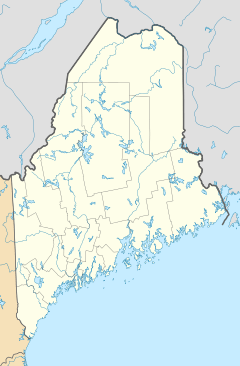Doubling Point Range Lights facts for kids
 |
|
| Front Light in foreground, Rear Light just visible, right of middle in the background | |
|
|
|
| Location | Kennebec River, Maine |
|---|---|
| Coordinates | 43°52′58.3″N 69°47′44.3″W / 43.882861°N 69.795639°W |
| Year first constructed | 1898 |
| Automated | 1980 |
| Tower shape | Octagonal Wood Tower |
| Markings / pattern | White |
| Focal height | Front:18 feet (5.5 m) Rear: 33 feet (10 m) |
| Characteristic | Front: Q W Rear: Iso W 6s |
| Fog signal | none, but see Fiddler's Reach Fog Signal |
| USCG number | Front: 1-6135 Rear: 1-6140 |
The Doubling Point Range Lights are two special lighthouses in Arrowsic, Maine. They stand on the Kennebec River. These lights were built in 1898 to help ships navigate the river. They are the only pair of their kind still standing in Maine! These lights are so important that they were added to the National Register of Historic Places in 1988. This means they are protected because of their historical value.
Contents
What are Range Lights?
Range lights are different from regular lighthouses. A regular lighthouse has one light. Range lights have two lights, one in front of the other. When a ship lines up the two lights, it knows it is in the safest part of the river channel. This helps ships avoid shallow areas or rocks.
Where are the Doubling Point Range Lights?
The Doubling Point Range Lights are located on the lower part of the Kennebec River. The river usually flows south. But at this spot, it makes a sharp turn to the east. Then it turns back to the south again. The range lights are placed on the north side of the second turn. Another lighthouse, the Doubling Point Light, marks the first turn.
What Does the Light Station Look Like?
The Doubling Point Light Station is made up of several buildings:
- Two tall, octagonal (eight-sided) wooden towers.
- A house where the lighthouse keeper used to live.
- A small building called an oil house.
The two towers are connected to the keeper's house. They have wooden walkways with railings. The tower closer to the river is about 17 feet (5.2 meters) tall. The tower further back is about 13 feet (4 meters) tall. When a ship is in the correct part of the river, only the front light can be seen. This tells the captain they are on the right path.
The keeper's house is an L-shaped wooden building. It has a sloped roof and a strong stone foundation. It also has covered porches on its east and west sides. The oil house is a small brick building. It has a pointed roof and a door in the middle. This building was used to store the oil for the lights.
Why Were They Built?
The Doubling Point Range Lights were built in 1898. This was 15 years after the Bath Iron Works started. The Bath Iron Works is a big company that builds ships. It is located just a short distance up the river.
These range lights were part of a big project to improve river navigation. At the same time, other important lighthouses were built. These included the Doubling Point Light, Perkins Island Light, and Squirrel Point Light. All these lights helped ships travel safely on the Kennebec River.
Images for kids
-
The Fiddler's Reach Fog Signal (left) was also tended by the Doubling Point Range Lights' keepers
-
The range as it appears on NOAA Chart 13296






